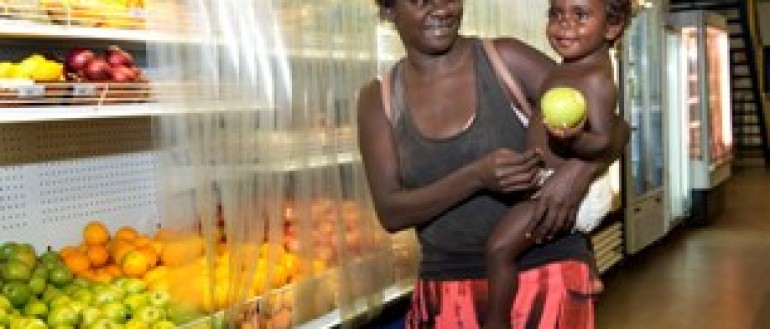The food environment strongly influences our food choices. We work with communities, stores, industry and schools to find effective strategies to improve diet.
At Menzies, we are working to address the gaps on the state of diet, determinants of diet and what works to improve diet. Our focus is to facilitate change at the population level. We are able to do this through strong partnerships with communities, stores, store associations, the NT Department of Health and our other partners.
We are acting on salt and sugar sweetened drinks and testing novel solutions to increase consumption of fruit, vegetables, water and other healthy food. The Stores Healthy Options Project in Remote Indigenous Communities (SHOP@RIC) is the largest nutrition related randomised trial to occur in remote Indigenous Australia. It has reached over 8500 residents and is one of four studies globally to test the impact of a price discount on healthy food purchasing. This trial built on a decade of observational studies and qualitative research conducted by our team that has contributed much needed evidence on diet and nutrition in remote Indigenous Australia.
- Associate Professor Julie Brimblecombe
- Dr Selma Liberato
- Dr Emma McMahon
- Anthony Gunther
- Rachael Jaenke
- Megan Ferguson
- Leisa McCarthy
Current projects:
- Healthy Stores 2020
- Food security and child health outcomes in Darwin/ Palmerston
Completed projects:
- The GOOD TUCKER app
- Act on Salt
- SHOP@RIC: Stores healthy options project in remote Indigenous communities
- Cost of dietary improvement project
- Galiwin’ku Healthy Lifestyle study
- Promotion and education in remote stores project
- Aboriginal Perspectives on Physical Activity
- Stores project
- Top End remote food gardens study and website
- Enough for rations and a little bit extra: Challenges of nutrition improvement in a remote Aboriginal community
- Survival tucker: Improved diet and health indicators in an Aboriginal community in North East Arnhem Land
- Brimblecombe, J.K., Ferguson, M.M., Liberato, S.C., & O'Dea, K. (2013). Characteristics of the community-level diet of Aboriginal people in remote northern Australia. Medical Journal of Australia, 198(7), 380-384.
- Brimblecombe, J., Ferguson, M., Liberato, S.C., O'Dea, K.,& Riley, M. (2013). modelling to assess cost of dietary improvement in remote aboriginal Australia. PLoS.One, 8(12), e83587.
- Magnus, A., Moodie, M.L., Ferguson, M., Cobiac, L.J., Liberato, S.C., & Brimblecombe, J. (2015). The economic feasibility of price discounts to improve diet in Australian Aboriginal remote communities. Australian and New Zealand Journal of Public Health. Jun 29 2015.
- Brimblecombe, J., Maypilama, E., Colles, S., et al. (2014). Factors Influencing Food Choice in an Australian Aboriginal Community. Qualitative Health Research, 24(3), 387-400.
- Brimblecombe, J.K., & O'Dea, K.(2009). The role of energy cost in food choices for an Aboriginal population in northern Australia. Medical Journal of Australia, 190(10), 549-551.
- Brimblecombe, J., Ferguson, M., Liberato, S.C., et al. (2013). Stores Healthy Options Project in Remote Indigenous Communities (SHOP@RIC): a protocol of a randomised trial promoting healthy food and beverage purchases through price discounts and in-store nutrition education. BMC.Public Health,13, 744.
- Hume, A., Wetten, A., Feeney, C., Taylor, S., O'Dea, K., & Brimblecombe, J. (2014). Remote school gardens: exploring a cost-effective and novel way to engage Australian Indigenous students in nutrition and health. Australian and New Zealand Journal of Public Health, 38(3), 235-240.
- Thompson, S.L., Chenhall, R.D., & Brimblecombe, J.K.(2013). Indigenous perspectives on active living in remote Australia: a qualitative exploration of the socio-cultural link between health, the environment and economics. BMC.Public Health, 13, 473.
- Jaenke, R., Barzi, F., McMahon, E., Webster, J., & Brimblecombe, J. (2016). Consumer Acceptance of Reformulated Food Products: A Systematic Review and Meta-analysis of Salt-reduced Foods. Critical reviews in food science and nutrition. Jan 8 2016:0. [Epub ahead of print]
- McMahon, E., Webster, J., O'Dea, K., & Brimblecombe, J. (2015). Dietary sodium and iodine in remote Indigenous Australian communities: will salt-reduction strategies increase risk of iodine deficiency? A cross-sectional analysis and simulation study. BMC Public Health,15(1), 1318.
- GOOD TUCKER app
- Talking About Shelf Labels
- Aboriginal Perspectives on Physical Activity report
- Enough for rations and a little bit extra: Challenges of nutrition improvement in a remote Aboriginal community - Thesis

